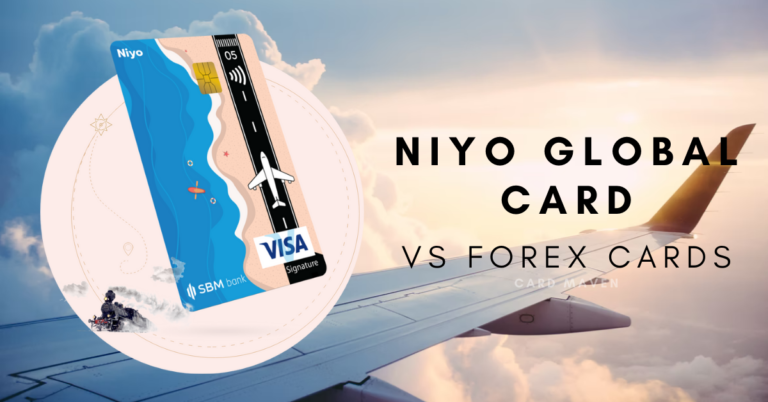The Fintech scene in India is always a happening one. We have Slice, Uni building credit cards on top of loans. On the other side, Cred lets us pay credit card bills and earn rewards. There are many more exciting products. Niyo Global card is one such Fintech that plans to replace the forex cards from banks. In this post, we will compare Niya Global vs forex cards and the charges, benefits.
What is Niyo Global card?
Niyo Global is a savings account built in partnership with SBM Bank. The USP of this account is Zero Forex Markup for foreign currency transactions.

When we use credit/debit cards in a foreign currency, we pay extra charges in the form of markup. This can go up to 3% in some cases. Niyo does not charge these fees. This can add up to good savings for someone who makes international transactions.
Features and Benefits
- Zero Forex Markup Charges
- Visa exchange rate for international transactions
- Real-time currency converter
- Up to 5% interest rate (Interest on incremental balances – 3.5% till 2L, 4% from 2L-5L, 5% above 5L)
- Visa Signature debit card
- Average Monthly Balance Requirement – NIL (Initial funding of Rs 5000)
- Complimentary Airport Lounge Access (via Visa)
- DICGC insurance cover of up to Rs 5 Lakhs (Bank Benefit)
- Annual Debit Card Fees – Rs 499
Niyo Global vs Forex Cards – Fees and Charges
| Type of Fee | ICICI Bank Multi-Currency Travel Card | HDFC Bank Multicurrency ForexPlus Card | Axis Bank Multi-Currency Forex Card | Niyo Global Card |
|---|---|---|---|---|
| Joining Fee | Rs 150 | Rs 500 | Rs 300 | NIL |
| Annual Fee | NIL | NIL | NIL | Rs 499 |
| Renewed Card Fee | Rs 100 | Rs 100 | Rs 100 | NIL |
| Reload Fee | Rs 100 | Rs 75 | Rs 100 | NIL |
Advantages over Forex Cards
Real-Time Currency Conversion
When we get a Forex card, we load the card by providing INR. This gets converted into the currency we choose like USD. This rate differs between banks and is higher than the ‘actual’ exchange rate. For example, at the time of writing this article on 17-Dec-2021 the USD-INR forex rates for loading travel cards at major banks are:
| ICICI Bank | HDFC Bank | Axis Bank | Niyo Global – VISA Exchange Rate |
|---|---|---|---|
| 77.67 | 77.65 | 79.15 | 76.32 |
As we can see Niyo provides a better rate via Visa. We lock the exchange rates when we load a forex card. This rate can increase/decrease from the time we get a travel card and finish our travel. Niyo Global uses the real-time VISA conversion rate at the time of transaction. This ensures we pay the current exchange rate only when we need it.

Converting Unused Balances
The second issue with forex cards is the cash-out process. We might have loaded 1000 USD when we got the forex card out of which we spent 900 USD. We need to encash the rest 100 USD through the respective bank.
This ‘buy’ rate for converting USD to INR is again lesser than the initial ‘sell’ price for the bank. This spread can be a lot. For example, at the time of writing this article on 17-Dec-2021 the USD-INR forex rates for cashing out travel card balances at major banks are:
| ICICI Bank | HDFC Bank | Axis Bank | Niyo Global – VISA Exchange Rate |
|---|---|---|---|
| 74.27 | 75.02 | 73.10 | Not Applicable |
We lose out when encashing the remaining balance on the forex card as the rates are lesser than what we bought it at. This again is an advantage for Niyo Global. As our money gets stored in INR and does not convert to USD unless we need it.
No Cross-Currency Charges
Forex cards can have a single currency or can be multi-currency as well. For single currency cards, we will have a default currency like USD or EUR. If we make a transaction in another currency, then we have to pay an extra cross-currency charge. This varies between different banks.

The 0% cross-currency charge is only for the ICICI Bank Sapphiro Forex card.
| ICICI Bank | HDFC Bank | Axis Bank | Niyo Global – VISA Exchange Rate |
|---|---|---|---|
| 3.5% | 2% | 3.5% | Not Applicable |
No Wallet to Wallet Transfer Fee
We are not done with the forex card charges yet. 🙂 Wallet to wallet transfer fee is applicable for multi-currency forex cards. These cards can be loaded with more than one currency. Consider a case where we have loaded EUR and USD on the card. In case of insufficient EUR balance for EUR transactions, the USD balance gets used.
| ICICI Bank | HDFC Bank | Axis Bank | Niyo Global – VISA Exchange Rate |
|---|---|---|---|
| 2.5% | 2% | 3.5% | Not Applicable |
My Take
Considering the charges on a Forex card and the lower conversion rates, Niyo Global is better. It is a normal savings account which we can use abroad and save our money.
It works for any currency and unless we transact we are not losing out on interest and forex charges. For safety, we can also lock our card from the app when we don’t plan to use it. This alleviates the safety concerns of using a debit card outside India.
It is easy to get a Niyo Global card as well. We can apply using the app. It only needs a PAN card and Aadhaar number. The physical debit card gets sent to our address after the account is opened.


1 thought on “Niyo Global vs Forex Cards”
Is Niyo Global Card available in Prayagraj Allahabad Uttar Pradesh?